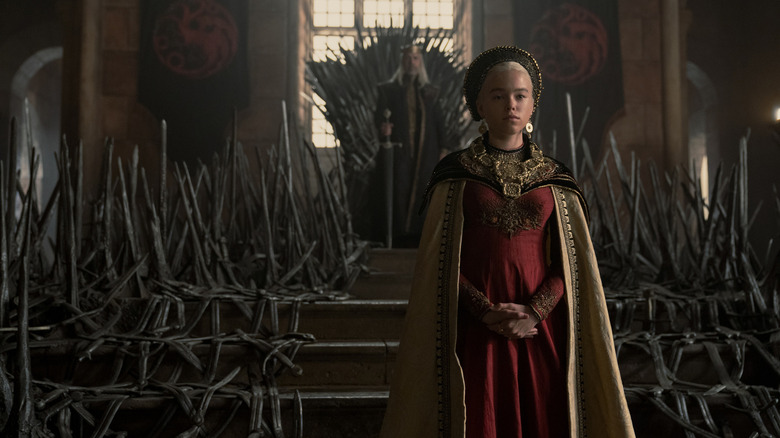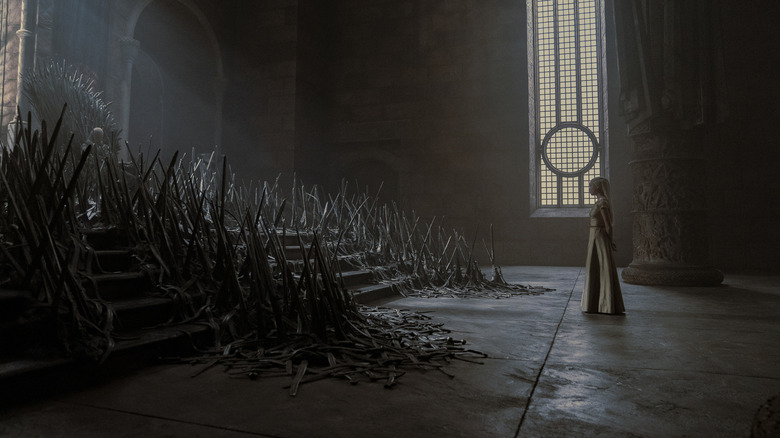Why The Iron Throne Looks Different In House Of The Dragon
Of all the memorable moments and iconography that "Game of Thrones" introduced to viewers during its (mostly) acclaimed run — awe-inspiring dragons, the disastrous Red Wedding, that majestic and towering Wall located up north — perhaps none measure up to the simple power of the constantly sought-after Iron Throne. As much as the series evolved into the kind of typical fantasy that involved zombies and end-of-the-world stakes, the early seasons were predominantly concerned with the nature of power and what kind of person would make for a good ruler ... if such a thing even exists, of course.
As the marketing for the spin-off/prequel series "House of the Dragon" has ramped up ahead of its impending debut, even casual viewers had to take note of just how different that big, sword-studded chair will be depicted in comparison to its incarnation 200 years later (until it was destroyed at the end of "Game of Thrones" by Drogon, the fire-breathing dragon with an uncanny knack for understanding symbolism, that is). Created from the melted-down weapons of various enemies during the Targaryens' original conquest of Westeros, the Iron Throne in "Game of Thrones" boasted a relatively simple and clean design — a notable departure from author George R.R. Martin's text, which describes a dreadful and ugly monstrosity made up of thousands of swords with a tendency to cut (or even kill!) any unwary ruler who dares ascend its many steps.
Amid the new show's many attempts to differentiate itself from the original, the Iron Throne itself will take on a noticeably different and more ancient-looking design. Why? The reason comes down to reflecting the themes of the new status quo in "House of the Dragon."
'The apex of the Targaryen empire'
In a new interview with Vanity Fair, "House of the Dragon" co-creator Ryan J. Condal addressed the new look that the Iron Throne will sport in the prequel series.
Logistics and resources always end up factoring into production design, and even a show as successful as "Game of Thrones" was no exception. As Condal explained, the bigger leash afforded to the creative team on "House of the Dragon" and the story's specific goals allowed them to expand their vision of the Iron Throne even more this time around:
"Yeah, we went into the series knowing that this was a time of high decadence. We consider this the apex of the Targaryen empire, so we really wanted to communicate this idea of wealth and prosperity and the fact that there had been six years of peace. The Targaryens really were able to develop all the nice things that happened: peacetime, statues and art, and roads and fountains.
... some of this is due to just, those poor guys ['Game of Thrones' showrunners David Benioff and D.B. Weiss] had a fifth of the resources that we have now. But thanks to the great success that they earned along the way, we were just given it when we walked in the door. We used that to really make this seem like the previous [show] feels like an empire in decay, the great dynasty has fallen, the Targaryens are gone."
By adding a plethora of mangled, twisted swords in and around the throne room area, Condal and Martin aimed to suggest an empire at its peak while conveying the idea that this show takes place much earlier than "Game of Thrones." More surprises undoubtedly lie in wait once "House of the Dragon" premieres August 21, 2022 on HBO.

